Vaults of Vaarn 2E: Launch Interview with Leo Hunt
#012 - From the blue desert to sky islands above ancient Urth
Vaults of Vaarn by Leo Hunt is a psychedelic science-fantasy TTRPG with minimalist rules that empower player creativity and an emphasis on procedural content generation. Vaarn is a surreal and colourful world, where the borders between magic, science, and faith have likewise become obscured.
It's hailed by many as a great work of wonderful OSR weirdness. With the Second Edition being crowdfunded NOW, we're happy to share this interview with Leo Hunt, the sole creator of this game.
The Interview
Alexander from Golem Productions (G.P.): Thanks again, Leo, for taking the time for this interview with OSR Rocks! We’re dedicated to old-school gaming, and you've described your game Vaults of Vaarn as OSR. In a nutshell, what does that mean to you?
Leo Hunt: Yeah, how long do we have? I mean, leaving aside the obvious roots in early D&D, what interests me about OSR is really the play style. It’s a different approach. My impression is that a lot of fifth edition play is built around backstories and the campaign is meant to fulfill that story arc. There’s nothing wrong with that, but what I prefer is when a character is defined by what they do once the game starts. OSR embraces these high player agency.
G.P.: Player agency: You give players tons of creative options. You can play a stone creature, a fungal person, a weird cyborg—that’s amazing. What’s the weirdest character anyone has made using your tools?
Leo: Actually, I’ll tell you the one that annoyed me the most! Someone just said, “I want to be an elf.” And I was like, “Okay…” It’s not really that kind of setting, but fine, this guy had pointy ears and a bow, and bless him, he was just really into being an elf. But the weirdest party? I think it was one I rolled up during solo playtesting—nobody in the party could talk, all for different reasons. It made dungeon crawling doable, but everything else got incredibly difficult.
G.P.: I remember reading a play report where someone played a fungal person (“Mycomorph”), and after getting wounded, they asked if they could heal by digesting enemy corpses. The referee said yes. That showed how much players enjoyed and embraced those weird optifons.
Leo: Yeah, I love that! There’s definitely a strain in the OSR of “humans only” fantasy, more restrained. And that’s fine. But I’m very much on the other side—I love weird player characters. I think it opens the door for creativity and for weird problem-solving, which OSR does so well.
Like, the weird character options in Vaults of Vaarn come with trade-offs. Stone people (“Lithlings”), for example, can’t heal. They just erode over time. But they’ve got all these cool immunities. It gives you a totally different experience based on what you choose. That’s what I want to offer.
G.P.: Looking back at the original zine, Vaults of Vaarn #1: it's a very straightforward zine mostly filled with creative tables. What advice would you give yourself today if you were starting again?
Leo: That’s a great question. I think there are two sides to it. On one hand, I wouldn’t change too much. That first zine was really successful for what it was and got me to where I am now. Some people still just use that original issue #1, which is wild. It’s like their OD&D, you know? But on the other hand, it’s not exactly a complete game. You needed to bring in a lot of external knowledge about the OSR playstyle to make it work. You had to already understand things like how to use procedural material to create a world, how to run a session in that style, and so on.
So with Second Edition, I’m trying to make it more accessible. I don’t assume everyone’s read the same blog posts I read five years ago. I added pages explaining the expected playstyle, where to start, how to build a world, that kind of thing. Just trying to think more about user experience.
G.P.: You described Second Edition as the “definitive edition” of Vaults of Vaarn. How sure are you about that? ;)
Leo: Famous last words, right? But yeah—I’m pretty sure. I'm very conscious of edition fatigue in the scene. I'm aware that in parts I'm asking people to buy the same thing again they bought three years ago. So, I’m really trying to be fair. Second Edition has a lot more content, but more importantly, I don’t want to reissue these rules again. I'm not interested in doing that creatively, and I don’t think it’s fair commercially.
So yeah, this is the definite core rule set. It won’t be updated again. Everything going forward—assuming the launch goes well—will be supplementary. New material, new regions, adventures, but the core rules are locked in.
G.P.: Speaking of the launch—give us the pitch! What can we expect from Vaults of Vaarn Second Edition?
Leo: Right, the main thing is a luxury hardback book. It’s 320 pages, larger than the zines, two color printing. Like I said, a director’s cut: player rules, tons of character options, vehicles, pets, followers—all expanded and procedural.
There’s also a very large GM section, which includes not just wilderness generation but detailed systems for generating dungeons and settlements by rolling dice, too. That’s probably the biggest new feature. I spent a lot of time testing those to make sure they work well. And then there’s a bestiary and an adventure section that gathers published adventures into the book. Everything from Issues #1 to #3, as well as Adventure Packs 1 and 2 is in the book, plus tons of new stuff.
Beyond the book, there’s a referee screen, an art print, and a digital soundtrack by Out On Our Own—long looping instrumental tracks for different environments: dungeon, wilderness, etc. That’s basically it. I’m keeping it simple, so I can actually deliver.
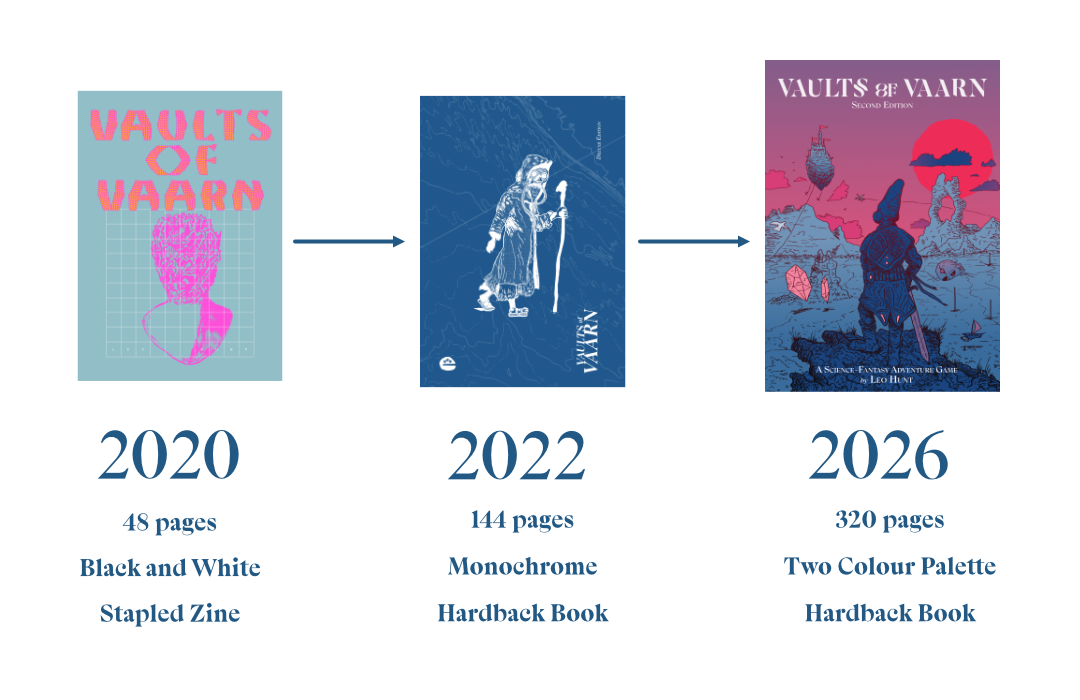
G.P.: Sounds like a strong foundation. Can you tell us a little bit more about the new magic system in the book? That also seems like a significant shift.
Leo: Yeah, that’s a big one. So, the original Vaults of Vaarn magic system is based on something called Mystic Gifts. It’s inspired by Christian Mehrstam’s The Whitehack, where spells are paid for with HP. They’re pretty freeform—you use keywords to loosely define the effect, and it can be almost anything. But they don’t always mesh well with other OSR content. Like, if you find a scroll of Water Breathing in a B/X module, it’s not obvious how to make that work in Vaarn.
That's where hypergeometric codexes come in, my worst-ever name. They are basically spellbooks. In Vaarn, there are weird structures of impossible design, like bigger on the inside than they are on the outside. These codexes contain knowledge of these impossible geometries, weird equations, and casting a spell means understanding the equation. You make an Intellect save to cast—and spells scale off Intellect—, and if you fail, you can’t cast again for the rest of the day. That’s the trade-off. It’s similar to systems like Shadowdark or Mythic Bastionland where abilities get exhausted. If you critically fail, you roll on a miscast table, which can do bizarre things like shrink you.
G.P.: I like that. High risk, high reward. And it makes Intellect matter more too, right?
Leo: Exactly. That was a design goal. In the original edition, players barely rolled it, and if it got damaged, it didn’t have much mechanical consequence. So now Intellect plays a role in multiple subsystems: alchemy, repairing vehicles, foraging—and magic. So it’s got real weight now.
G.P.: That’s brilliant. Let me then ask about another key design element of Vaults of Vaarn—procedural generation. It's such a distinctive feature of your work. Why did you decide to focus so much on it?
Leo: Yeah, that’s really at the heart of the game. Yoon-Suin by David McGrogan was a huge influence on me. That book taught me how tables can create a setting that’s specific and idiosyncratic, not just generic filler.
There’s a misconception that procedural generation is about avoiding work—but that’s not true. Getting it to work well takes just as much effort as writing content outright. You have to build the framework, the probabilities, and make sure the combinations it spits out are meaningful and evocative. I think what makes Vaarn unique is that it’s both deeply random and distinctly itself. The way that it’s expressed is through random tables but their totality is telling you something about the world. People tend to agree it’s not a generic world, it's a very specific one.
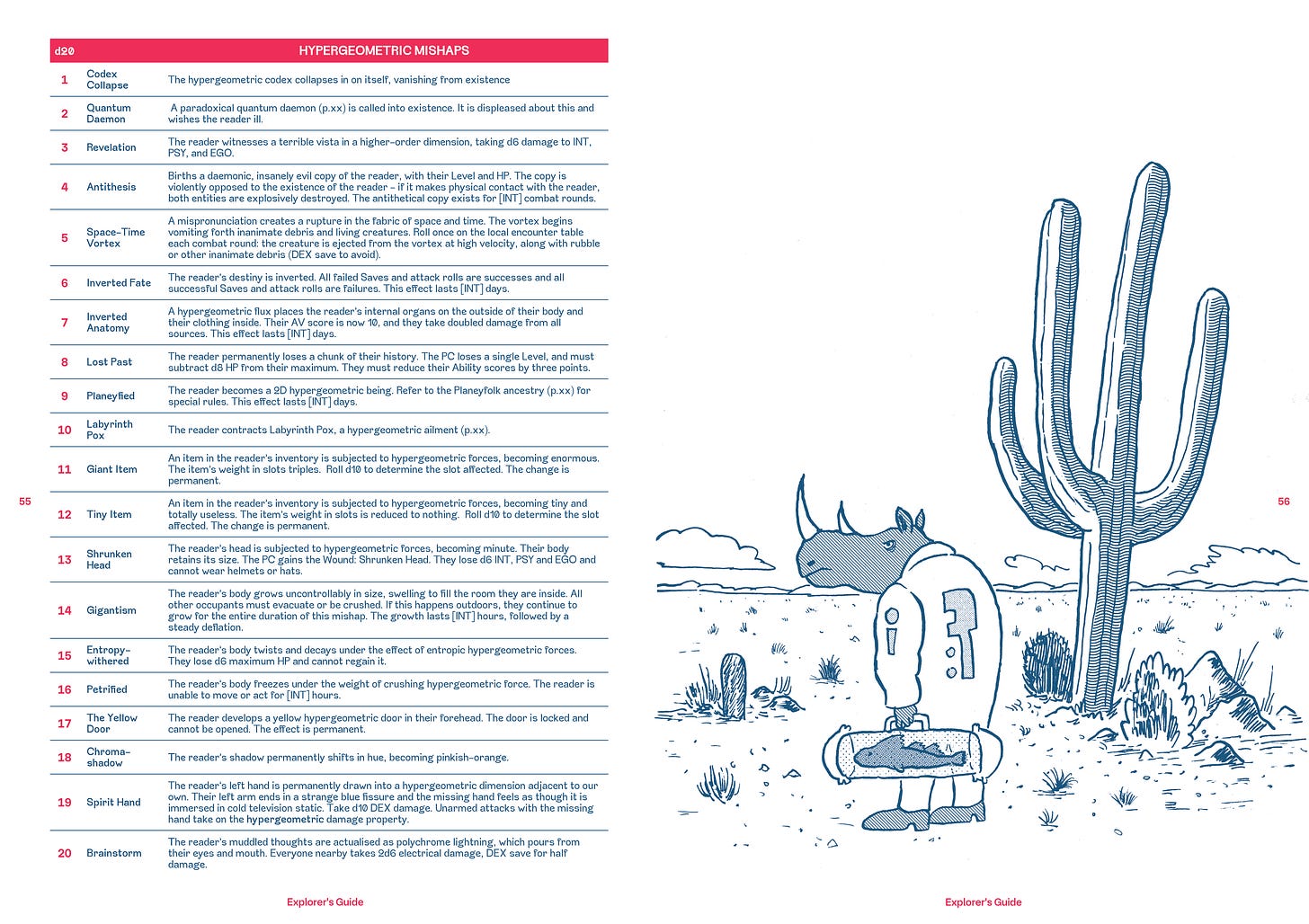
G.P.: That’s a beautiful way to put it. But I imagine it could be a bit daunting for new GMs, especially those used to pre-written adventures or detailed settings like in, let's say, Dolmenwood.
Leo: For sure. And I’ve tried to address that in Second Edition. The GM section walks you through how to prep with procedural tools. There’s a part that talks about “campaign scope”—whether you’re prepping for a single session or a full sandbox—and recommends what to roll up and how much.
G.P.: How much do you prep in advance?
Leo: The advice is basically: don’t overprep. If you’re running a single session, you don’t need the whole region mapped. Maybe prep one dungeon with a few rooms. That’s enough. So I encourage people to roll in advance when possible—especially for things like locations. Improvising a shopkeeper is one thing. Improvising a full settlement with many characters and conflict? That’s much harder.
G.P.: You’ve definitely put a lot of thought into guiding your readers. And I know you’re also working on some tools for adding story elements without turning it into a linear plot.
Leo: Yeah! I’m experimenting with lightweight “story prompts.” Not plots, but faction related events or storylines that you can put in if you think you need something to shake up your sandbox. Like a crashed space station everyone wants to reach, or a giant white sandworm attacking trade routes. These are regional events players can engage with or ignore, but they create momentum.
G.P.: That leads into another question I had. Your earlier work was known for being built entirely on random tables. But with The Shrike, nominated for an ENNIE, and even Vaults of Vaarn #4, there seems to be a shift. Are you moving toward more traditionally authored content?
Leo: Yeah, I think that’s a fair observation. I became known as the “guy who writes dice tables,” and I still love procedural generation. But I was a novelist before all this, and I’ve always enjoyed writing more straightforward prose, characters, and locations with real specificity. There’s something nice about just presenting an idea directly, not hiding it behind prompts.
I think that’s the tension I’m working through right now—how to balance authored material with tools. The Shrike is very authored: specific named NPCs and concrete locations rather than random ones. It still has tables where they’re useful—like for character generation—but it’s more of a traditional adventure module. And yeah, that fed back into Vaults of Vaarn. For example, in Issue #4, there are two big cities in the Wall—those are more fleshed out, not just implied through tables. I had very specific ideas about what these were like rather than generic ones.
G.P.: And it sounds like that’s continuing in the future, too?
Leo: Absolutely. I’m working on Issue #5 right now, which is set in a swamp region (“Ikor Quag”). That one has a central conflict between a fungus god named Belphegor and a fire-worshipping church trying to burn it out. It’s a conflict that players can intervene in. And as an example, a focus point is where this fungal god actually resides. That location can’t be a random location because it's quite important. But I still want people to be able to customize it. So, I’m thinking about using a depth crawl system, or maybe having a dice-drop map with one fixed location in the middle. There’ll still be random elements, but the authored parts are growing.
One of the next ideas I’m excited about, which I actually haven’t talked about at all, is what I call the Sky Islands of Vaarn—a set of 20 flying islands. Each one will be fully authored, different from each other, but you can drop them into a campaign as random encounters, or run them as a full campaign, arranged in a sky archipelago setting with airships and everything. So, there will be more specific, authored content, but always mixed with procedural tool-kits.
G.P.: That sounds amazing. Thank you for sharing a glimpse into the future. Now, we've mostly talked about Vaults of Vaarn, as Second Edition is just around the corner. But I want to zoom out for a moment: what games or adventures inspire you?
Leo: I have to shout out Yoon-Suin by David McGrogan. It’s so flavorful, so idiosyncratic. It’s this strange blend of fantasy China and India, inhabited by anthropomorphic bug people. It sounds like it shouldn’t work, but it does—and that mix of specificity and weirdness really shaped how I approach Vaarn.
Two more recent inspirations: Mythic Bastionland by Chris McDowall, and Wolves Upon the Coast by Luke Gearing. Chris managed to integrate a plot into a procedural game—he has these six myths pulling at the players throughout the campaign, and the way they emerge and overlap is really smart. It’s elegant, but it still feels organic.
And Wolves Upon the Coast is just amazing. It’s a full re-imagination of OD&D, set in a mythic Dark Ages Europe. It’s got this cool boasting mechanic where characters level up by declaring and fulfilling heroic deeds. It’s so flexible and fun in play and people are trying to one up each other. It’s great. If folks haven’t read it, they should.

G.P.: Last question. You mentioned “bigger on the inside” structures and impossible spaces. So... where does The Doctor go when they land in Vaarn?
Leo: [laughs] Oh, the Doctor would love Vaarn. I think they’d be trying to negotiate peace between the Water Baron and some bizarre new cult, while also dealing with sentient mushrooms and weird geometry. They’d sort it all out with a speech and a screwdriver. And then vanish before anyone could thank them.
G.P.: Perfect. Leo, thank you so much for your time and insight. This has been a real pleasure—and I’m sure our readers will love getting a deeper look into what’s ahead for Vaults of Vaarn.
Leo: Thank you! I appreciate the thoughtful questions.
P.S. Golem Productions to launch Kickstarter on August 12th!
Ravaged by Storms is a 72-page sandbox adventure designed for Pirate Borg, but easily adaptable to many other OSR systems. It features:
A multi-session campaign framework throughout the Death Wind Islands, a remote archipelago fought over by a mythical Coatl and 3 human factions.
9 fleshed out locations full of danger, adventure, and treasure, many of them suitable for one-shots.
Procedures, hooks, rumors, and encounters to explore these forgotten islands with dynamic faction activities.
Over 40 pieces of original art by Sabrina Jatscha, hand drawn, including maps, NPC portraits, and illustrations of your surroundings.
Plus new monsters, story-altering relics, the Storm Generator, Ruin Generator, and more!
“From pebble to monolith—your journey matters. The Golems have spoken.”
Alexander from Golem Productions




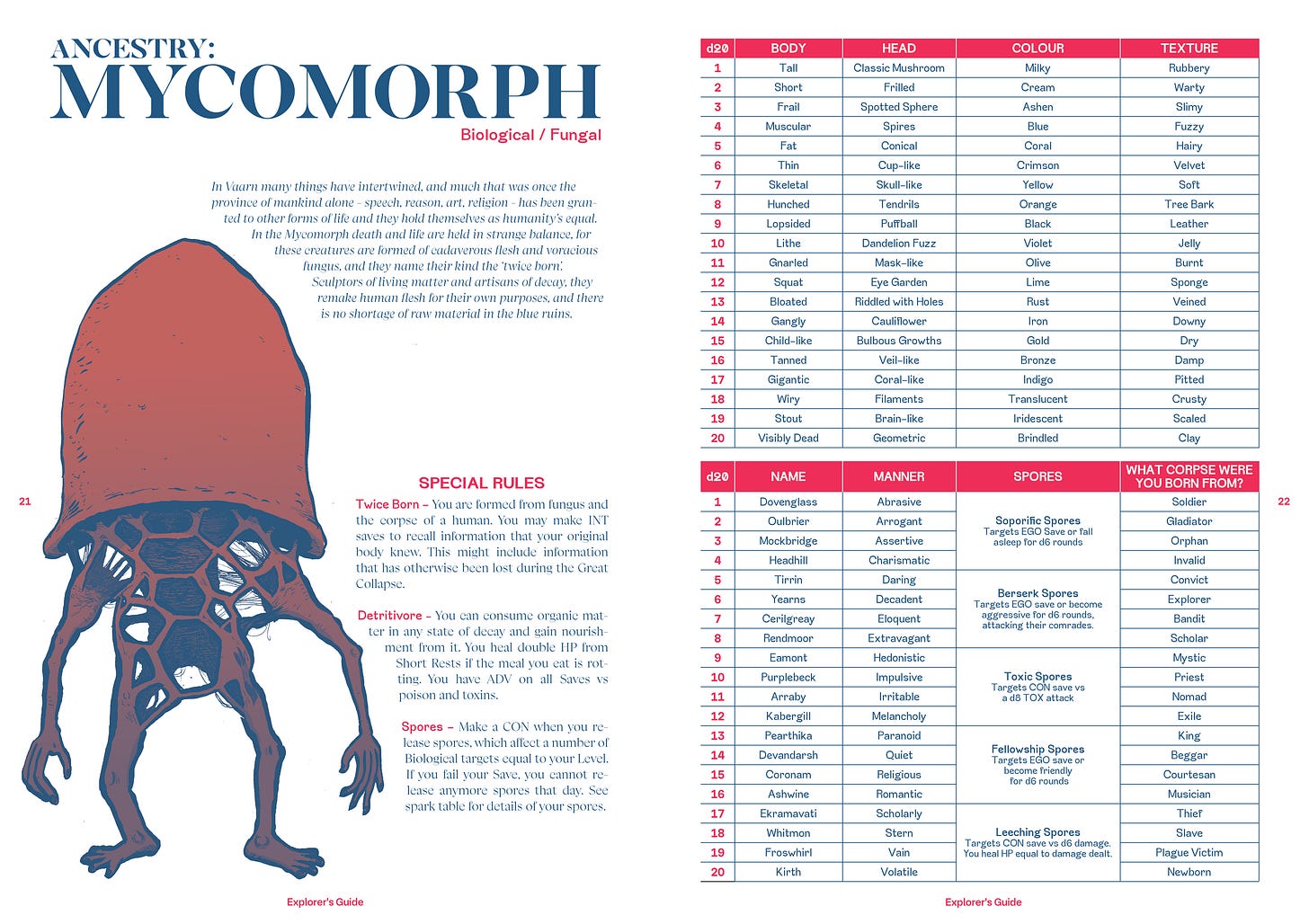
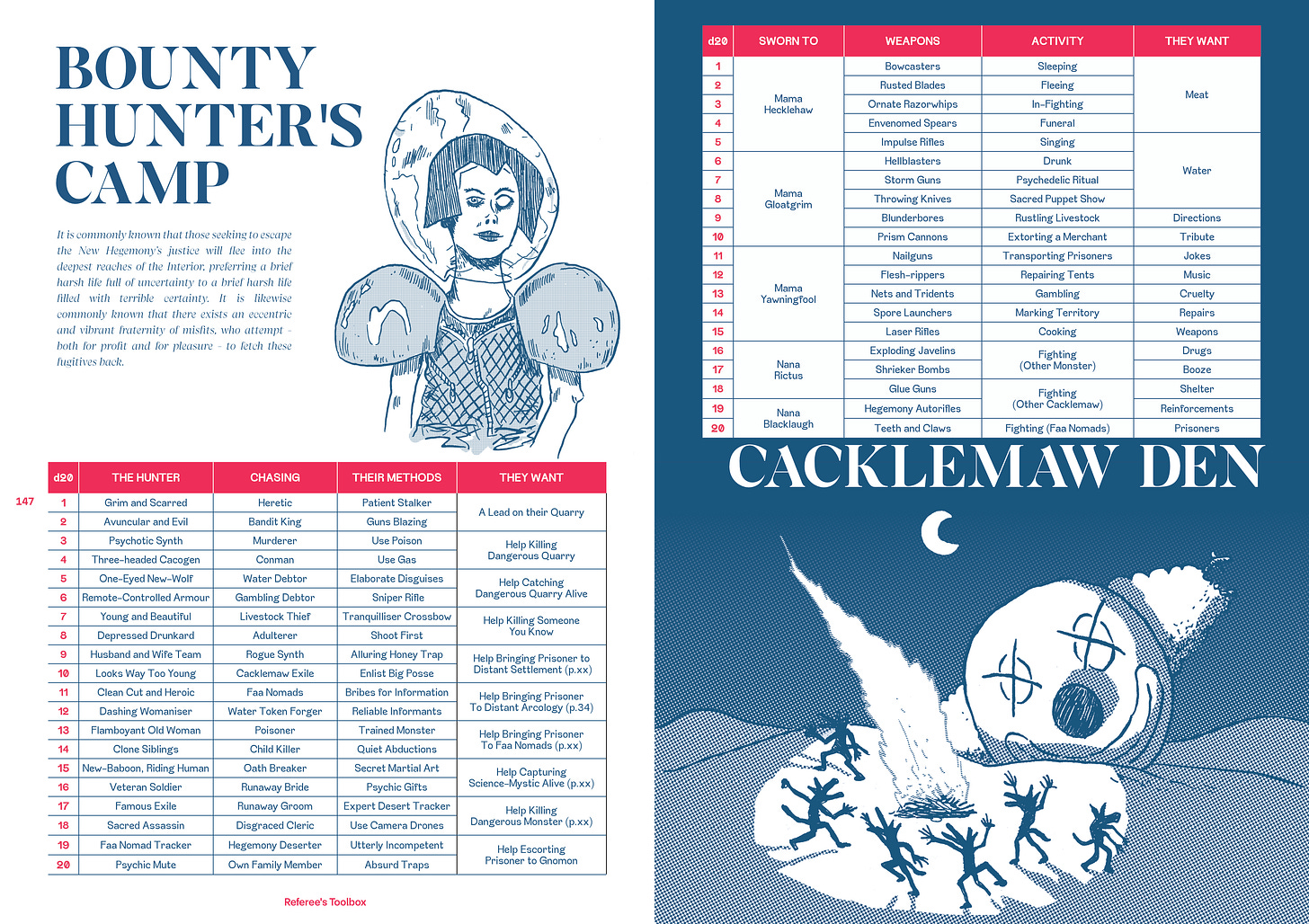
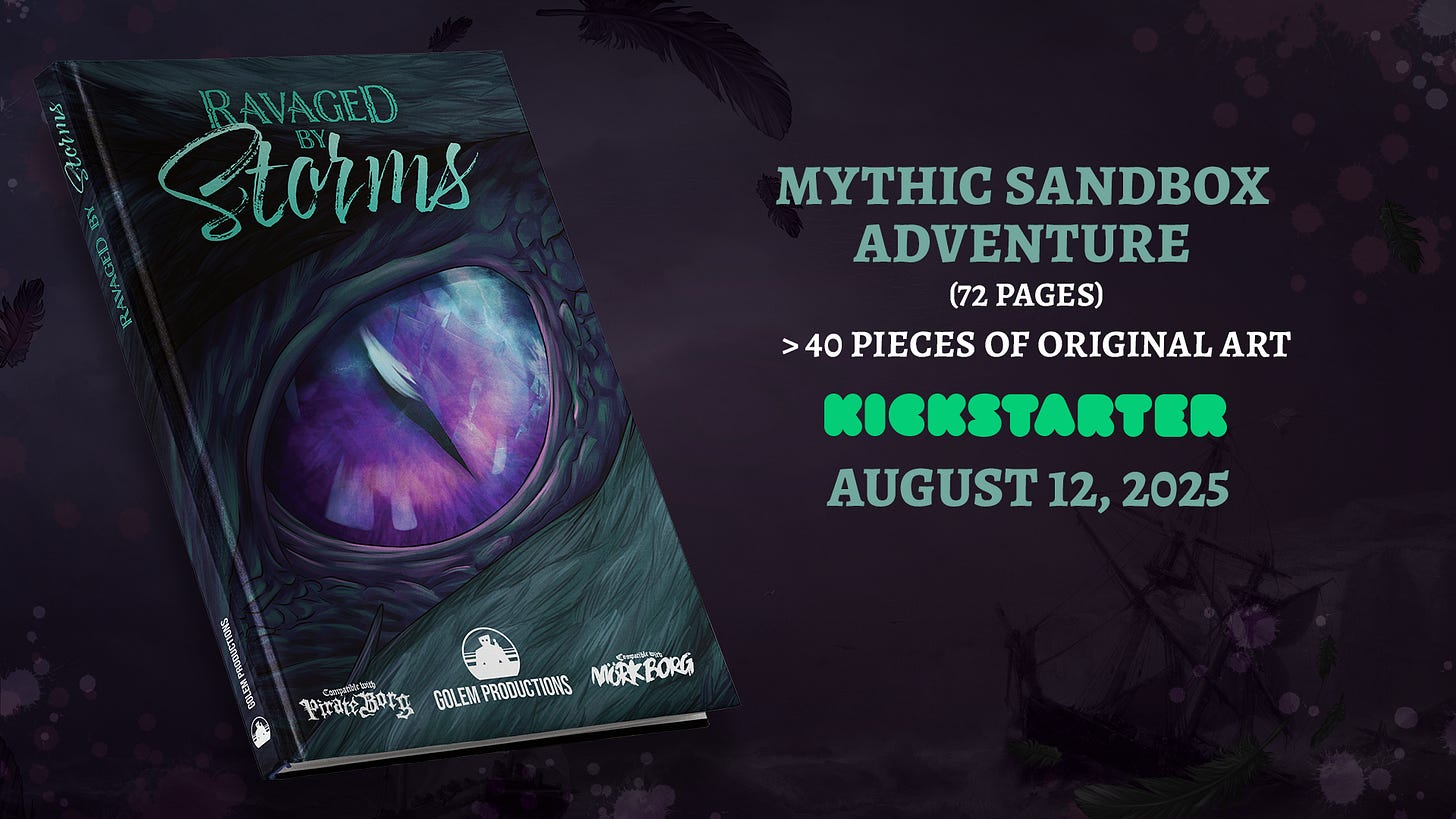
Great interview—love Leo’s concepts.